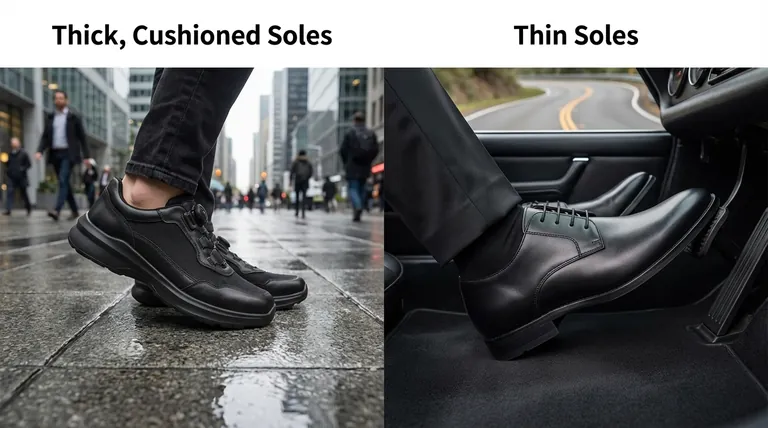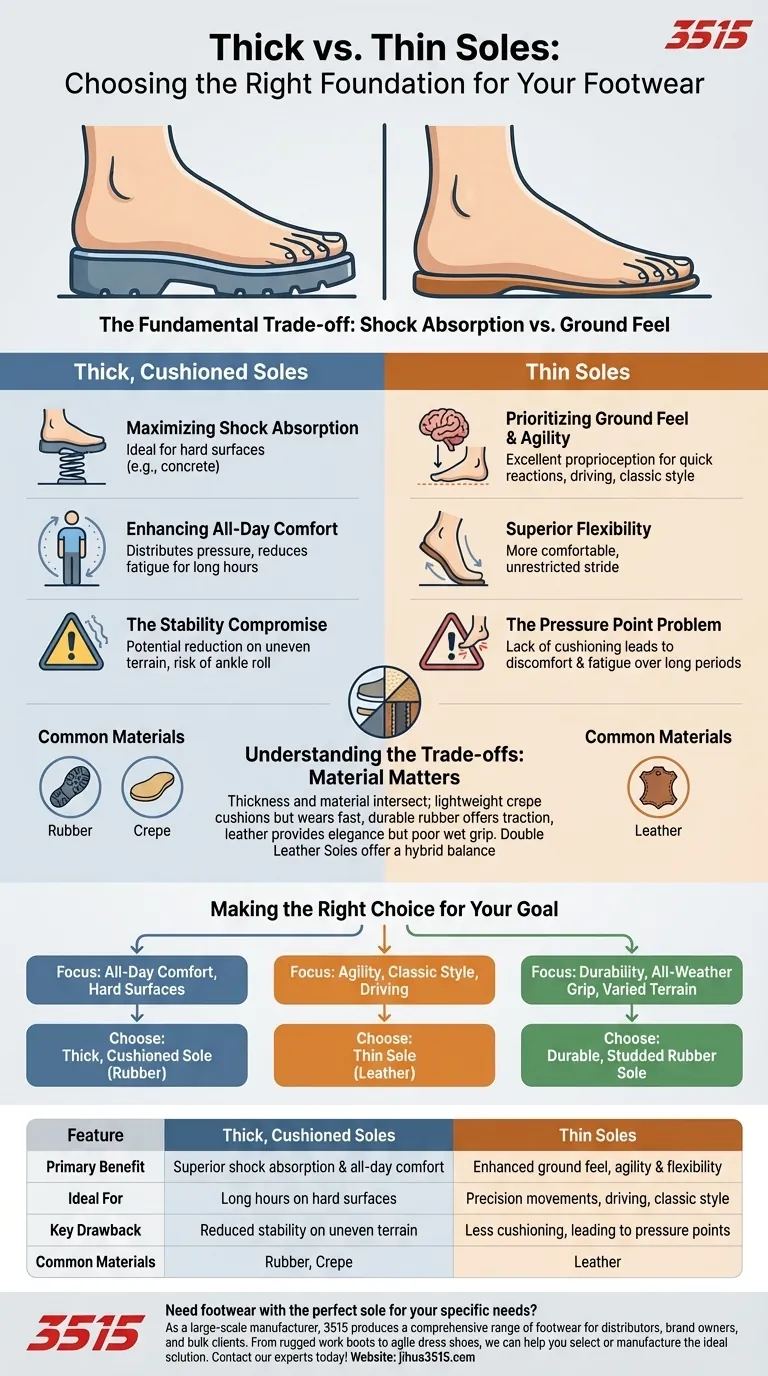Choosing between thick and thin soles is a fundamental trade-off between shock absorption and ground feel. Thick, cushioned soles are designed to protect your feet from impact, making them ideal for long days on hard surfaces. In contrast, thin soles offer greater flexibility and a more direct connection to the ground, which enhances agility and stability.
The ideal sole thickness isn't about one being universally better; it's about aligning the sole's properties with your intended activity. Cushioned soles absorb the impact of hard surfaces, whereas thin soles provide the stability and feedback needed for uneven terrain or precision movements.

The Case for Thick, Cushioned Soles
Maximizing Shock Absorption
Thick soles, often made of materials like rubber or crepe, excel at absorbing impact. This cushioning is critical when walking or standing on hard, unforgiving surfaces like concrete.
Each step sends a shockwave up your leg, and a cushioned sole acts as a dampener, protecting your joints and reducing overall fatigue.
Enhancing All-Day Comfort
The primary benefit of a thick, cushioned sole is comfort over extended periods. By distributing pressure and softening impact, these soles prevent the foot soreness that can build up throughout the day.
This makes them a superior choice for professions that require long hours of standing or for extensive city walking.
The Stability Compromise
The main drawback of a thick sole is a potential reduction in stability. The added height creates more distance between your foot and the ground, which can feel less stable and increase the risk of an ankle roll, especially on uneven or tricky terrain.
The Advantage of Thin Soles
Prioritizing Ground Feel and Agility
Thin soles provide excellent proprioception, which is your body’s ability to sense its position in space. This direct feedback from the ground allows for quicker reactions and more precise movements.
This enhanced agility is why many driving shoes and classic dress shoes feature thin, flexible soles.
Superior Flexibility
Often constructed from leather, thin soles bend more naturally with the motion of your foot. This flexibility allows for a more comfortable and unrestricted stride, avoiding the stiff or clunky feeling that some thick soles can create.
The Pressure Point Problem
The lack of cushioning is the thin sole's most significant weakness. Without a buffer, the impact of walking is concentrated on the pressure points of your foot, which can lead to discomfort and fatigue, especially during a long day.
Understanding the Trade-offs: Material Matters
The choice isn't just about thickness; the material of the sole plays a critical role in its performance. The benefits and drawbacks of a sole's thickness are directly influenced by what it's made of.
How Thickness and Material Intersect
A thick sole made of lightweight crepe offers a soft, bouncy cushion but wears down quickly. A thick rubber sole, like Dainite, provides durable, all-weather traction with a firmer feel.
Similarly, a thin sole is most often leather, prized for its elegance and flexibility but notorious for its poor grip in wet conditions.
Double Soles as a Hybrid
Some footwear uses a double leather sole. This is an attempt to gain the protective benefits of a thicker sole while retaining the classic construction and aesthetic of leather.
It provides more durability and protection from rough surfaces than a single leather sole but remains less cushioned than a comparable rubber sole.
Making the Right Choice for Your Goal
Your daily environment and primary activities are the ultimate guide to selecting the right sole.
- If your primary focus is all-day comfort for walking on hard surfaces: Choose a thick, cushioned sole, likely made of rubber, to maximize shock absorption.
- If your primary focus is agility, a classic style, or driving: Opt for a thin leather sole, which provides excellent ground feel and flexibility.
- If your primary focus is durability and all-weather grip on varied terrain: Consider a durable, studded rubber sole that offers a balance of stability and protection without excessive height.
By matching the sole's characteristics to your specific needs, you ensure your footwear performs exactly as you need it to.
Summary Table:
| Feature | Thick, Cushioned Soles | Thin Soles |
|---|---|---|
| Primary Benefit | Superior shock absorption & all-day comfort | Enhanced ground feel, agility & flexibility |
| Ideal For | Long hours on hard surfaces (e.g., concrete) | Precision movements, driving, classic style |
| Key Drawback | Reduced stability on uneven terrain | Less cushioning, leading to pressure points |
| Common Materials | Rubber, Crepe | Leather |
Need footwear with the perfect sole for your specific needs?
As a large-scale manufacturer, 3515 produces a comprehensive range of footwear for distributors, brand owners, and bulk clients. Our production capabilities encompass all types of shoes and boots, from rugged, cushioned work boots for all-day comfort to agile, thin-soled dress shoes. We can help you select or manufacture the ideal footwear to match your customers' activities and environments.
Contact our experts today to discuss your sole requirements and get a custom solution!
Visual Guide

Related Products
- Wholesale Modern Comfort Shoes with Dial Closure for Private Label & Bulk Orders
- Premium KPU Athletic Safety Shoes for Wholesale
- Wholesale Breathable Training Shoes Custom Athletic Footwear Manufacturer
- Lightweight Breathable Training Shoes for Wholesale & Custom OEM Manufacturing
- Durable Rubber-Soled Utility Shoes for Wholesale & Custom Brand Manufacturing
People Also Ask
- What special requirements should work shoes for all-day wear meet? Key Features for All-Day Comfort & Safety
- What are mesh dress sneakers and why are they suitable for business casual attire? Modern Comfort Meets Professional Style
- What should be considered when choosing work shoes for office and professional settings? Find the Perfect Balance of Style & Support
- What features should teachers look for in work shoes? Find All-Day Comfort & Support
- What are the key features of shoes for flight attendants? Unlock All-Day Comfort & Professional Style



















